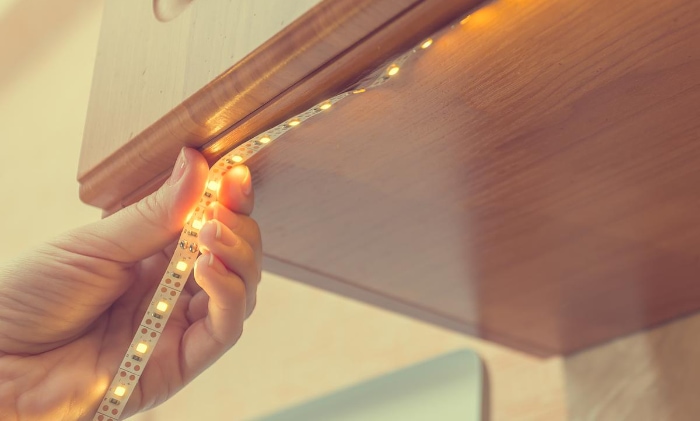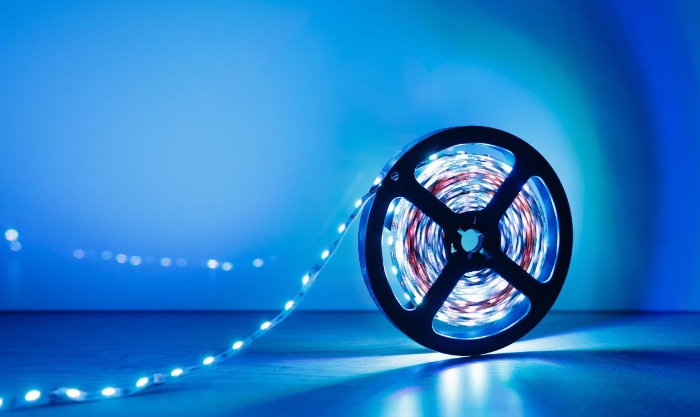LED Strip Lights: Causes of Color Shifts

LED strip lights have taken the world of interior and exterior design by storm, offering a versatile and energy-efficient solution for lighting up spaces in a multitude of vibrant colors. Yet, for all their technological sophistication, these devices sometimes puzzle their owners by unexpectedly changing colors on their own.
While this phenomenon might seem like a whimsical quirk or even an annoying defect, the underlying causes are rooted in electrical engineering, software design, and human factors.
Electrical Interference as a Cause
Electrical interference stands as one of the significant factors that could cause your LED strip lights to change colors autonomously.
What is Electrical Interference?
Electrical interference, also known as electromagnetic interference (EMI), is a disturbance that affects electrical circuits due to electromagnetic waves. These disturbances can alter the normal operational behavior of electronic devices, including LED strip lights.
In simpler terms, when an unrelated electrical device sends out a signal or has a fluctuation in power, this can interfere with the color control circuitry of your LED strip lights.
Sources of Electrical Interference
Various devices around the home or workplace can serve as sources of electrical interference. Household appliances like microwaves, refrigerators, and even Wi-Fi routers can generate electromagnetic waves strong enough to disrupt your LED lighting system.
In industrial settings, machines that utilize high electrical currents can be significant culprates.
How Electrical Interference Affects LED Strips
Electromagnetic waves can disrupt the signals going to the LED strip's control unit, causing it to receive false information. This false data can change the strip's output color or pattern without any manual input from the user.
In smart LED systems, this interference can also confuse the system's software, leading to similar color changes.
Identifying Electrical Interference
Pinpointing the exact source of electrical interference can be challenging. One method to test for interference is to switch off potentially interfering devices one by one and observe any changes in the LED strip’s behavior.
Another approach involves using specialized equipment like electromagnetic field (EMF) meters to detect unusual levels of electromagnetic waves near the LED strip setup.
Software and Firmware Issues
When LED strip lights change colors without any user input, software and firmware issues often lurk behind the scenes.
The Role of Software and Firmware in LED Strips
Software and firmware act as the brains behind the operation of smart LED strip lights. While the software is generally the interface through which users control the lights via a smartphone app, the firmware is embedded within the hardware to manage the light’s core functions.
Both of these digital layers must work in harmony for the LED strip to function as intended.
Outdated Software and Firmware Issues
Running on outdated software or firmware can introduce bugs or incompatibilities that result in unpredictable color changes. Manufacturers frequently release updates to fix such issues, enhance performance, and add new features.
Missing these updates can leave your LED strip susceptible to malfunctions.
Identifying Software or Firmware-Related Problems
To discern whether your issue is software or firmware-related, you can conduct a few diagnostic tests. One approach is to check if your software and firmware versions are up-to-date.
If not, updating them and observing any changes in the LED strip's behavior can be revealing. Another method is to reset the software or firmware to its factory settings, which will help you identify if a recent change or update is causing the problem.
Risks of Ignoring Software and Firmware Updates
Failure to keep software and firmware up-to-date can lead to an array of complications beyond spontaneous color changes. Security vulnerabilities, decreased functionality, and even total system failure are all potential risks.
Troubleshooting Steps for Software and Firmware Issues
- Check for Updates: Always ensure you're using the latest version of the software and firmware. Most apps will have a ‘Check for Updates' feature in their settings menu.
- Factory Reset: Reverting your LED strip lights back to their original settings can help you identify if a specific change is causing the issue.
- Consult Manufacturer Support: If you’ve updated and reset your system without resolution, contacting the manufacturer's support service for expert guidance is advisable.
- User Community Insights: Online forums and user groups can offer invaluable tips and workarounds for software and firmware problems that are specific to your LED strip model.
Mechanical Failures

Mechanical failures in LED strip lights can lead to a range of issues, including unpredictable changes in color.
The Anatomy of an LED Strip Light
Each LED strip consists of various mechanical components such as LED chips, resistors, and connectors. All of these parts are interconnected through circuitry, forming a complex system that manages light intensity and color.
Types of Mechanical Failures
Mechanical failures commonly manifest as loose connections, degraded components, or broken circuit pathways. Any of these issues can disrupt the flow of electrical current, thereby affecting the LED strip's ability to maintain a consistent color output.
Warning Signs of Mechanical Failures
Some indicative signs of mechanical failures include flickering lights, irregular color patterns, or portions of the LED strip not lighting up at all. These anomalies are usually good indicators that a mechanical failure is disrupting the normal operation of the strip.
Inspection Methods for Mechanical Failures
To inspect for mechanical failures, begin by examining the LED strip and its connections visually. Look for any loose or disconnected wires, degraded components, or any signs of physical damage.
A multimeter can also be used to check for continuity and ensure that electrical current is flowing as it should.
Resolving Mechanical Failures
- Reconnect Loose Wires: Make sure all connections are snug and secure. Sometimes, a simple reconnection can solve the issue.
- Replace Damaged Components: If any of the LEDs or resistors appear damaged, they may need to be replaced. Many LED strip kits come with spare components for this purpose.
- Solder Broken Circuitry: In cases where the circuitry has a break, a quick soldering job may be needed to restore function.
- Consult a Professional: If the issue persists despite your troubleshooting efforts, consider seeking help from a qualified electrician or technician familiar with LED systems.
Possible Manufacturer Defects
Not all problems with LED strip lights changing colors spontaneously are due to external factors or user error; sometimes, the fault lies with the manufacturer.
What Constitutes a Manufacturer Defect?
A manufacturer defect refers to a flaw or fault in the product that occurs during the manufacturing process. This could be anything from faulty wiring to subpar LED chips, affecting the overall performance and reliability of the LED strip.
Common Manufacturer Defects Affecting LED Strips
Some typical manufacturer defects include inconsistent soldering, improperly aligned LED chips, and poor quality control on resistors or other components. These defects can contribute to erratic changes in color, flickering, or even complete failure of certain segments of the LED strip.
How to Identify Manufacturer Defects
To determine if your LED strip has a manufacturer defect, one of the best initial steps is to consult user reviews and forums specific to your product model. Multiple reports of similar issues can often indicate a widespread defect. Additionally, visual inspection for obvious signs of poor craftsmanship can also be revealing.
Warranty and Returns
If you suspect a manufacturer defect, the first course of action should be to consult the product's warranty information. Most LED strip lights come with at least a one-year warranty, offering you the opportunity for a free repair or replacement.
Ensure you follow the manufacturer's guidelines on how to make a warranty claim to expedite the process.
Next Steps if You Encounter a Manufacturer Defect
- Document the Issue: Take photographs or videos to clearly capture the defect, as you may need to provide these to the manufacturer.
- Contact Customer Support: Reach out to the manufacturer’s customer support to report the issue and ask for troubleshooting steps, which will also serve as documentation of your complaint.
- Initiate a Warranty Claim: If customer support confirms that it’s likely a manufacturer defect, initiate the warranty claim process as directed.
- Seek Third-Party Assessment: If the manufacturer is unresponsive or disputes your claim, getting an independent assessment from a qualified technician can strengthen your case.
Environmental Factors
LED strip lights, like any electronic devices, can be sensitive to their surrounding environment.
Influence of Temperature on LED Strips
LED strip lights are sensitive to extreme temperatures, both hot and cold. These temperatures can affect the efficiency of the LED chips and the circuits connecting them. Fluctuations in temperature can cause unstable power supply to the LEDs, resulting in irregular color outputs.
Role of Humidity in Affecting Performance
Humidity levels can significantly impact the electrical components of LED strip lights. Excessive humidity can lead to condensation, which in turn can short-circuit the connections or even lead to corrosion over time.
Both of these outcomes can contribute to erratic color changes in the LED strip.
Light Exposure and Its Consequences
Long-term exposure to direct sunlight can also affect LED strips. Ultraviolet rays can degrade the material of the LED strip over time, affecting both the color and the structural integrity of the strip.
Identifying Environmental Factors
- Temperature Checks: Use a thermometer to check if the LED strip is installed in an area with temperature extremes. If so, consider relocating it.
- Humidity Level Assessment: A hygrometer can help you measure the moisture level in the environment. If it's too high, you might need to consider using a dehumidifier or relocating the LED strip.
- Assess Light Exposure: Check the amount of direct sunlight the LED strip receives during the day. If it's significant, you might want to think about installing shades or moving the LED strip to a less exposed area.
Remedial Actions for Environmental Factors
- Relocate the LED Strip: If you find that temperature, humidity, or light exposure is affecting the LED strip, moving it to a more suitable location can solve the issue.
- Use Protective Casings: Special casings are available that can protect the LED strip from environmental damage. These are especially useful for strips installed outdoors.
- Regular Maintenance: Wiping down the LED strip to remove dust and checking for signs of wear and tear can help you catch and address environmental impacts before they become a problem.
Conclusion
It's evident that multiple factors can contribute to LED strip lights changing colors by themselves. From electrical interference and software glitches to mechanical breakdowns, manufacturer defects, user errors, and environmental variables, each factor offers its own set of challenges and solutions.
By being aware of these aspects and knowing how to diagnose and address them, you can not only resolve the issue at hand but also enhance your overall experience with LED strip lighting. It's essential to adopt a holistic approach, taking into consideration each potential culprit, to effectively troubleshoot and maintain the performance of your LED strip lights.


